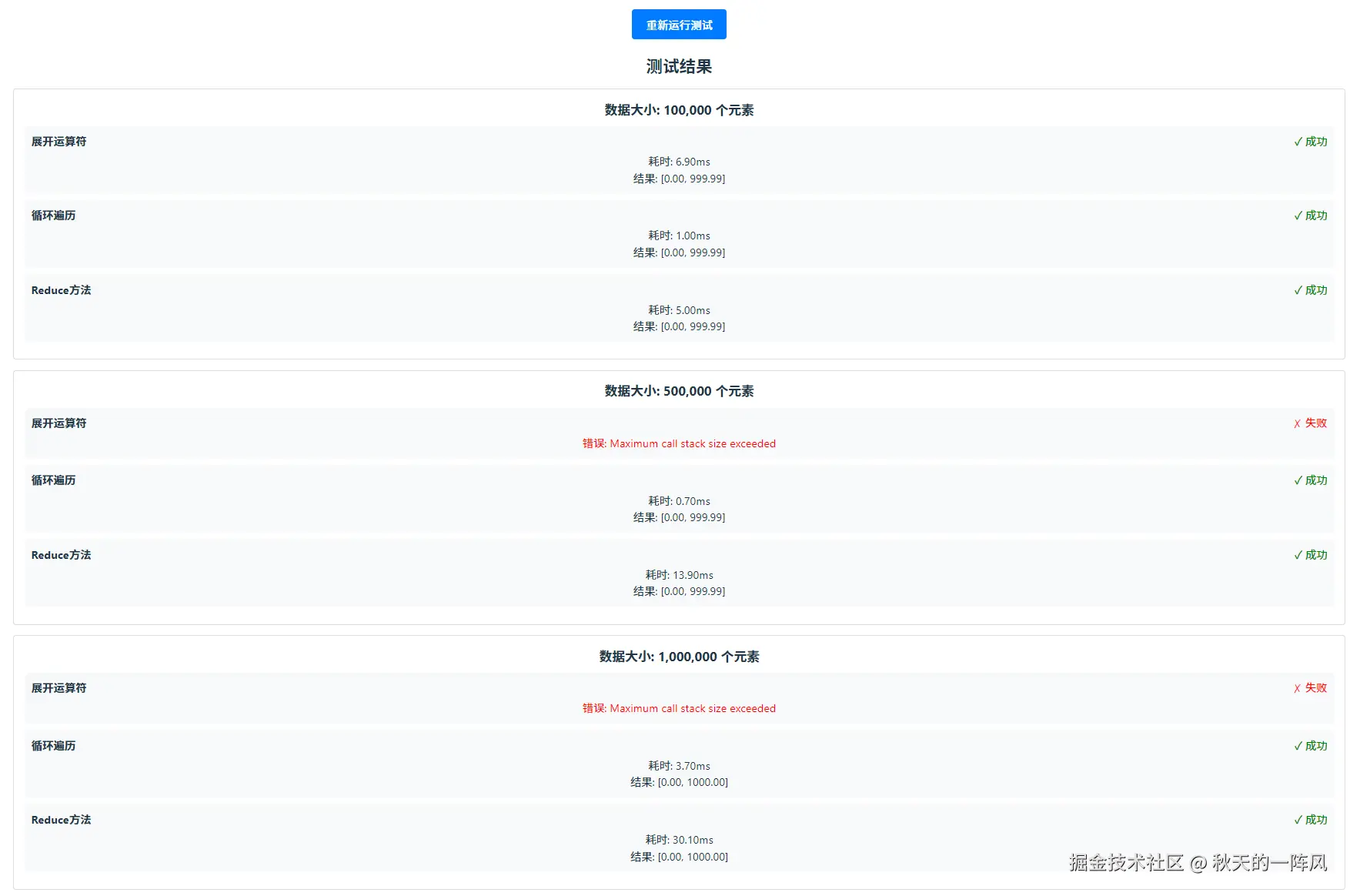前言:一个看似简单的 bug
Hello~大家好。我是秋天的一阵风
最近在负责开发我司的一个图表功能时,遇到了一个令人困惑的问题。用户反馈在特定操作下会出现 Maximum call stack size exceeded 错误,但这个问题只在特定条件下出现:选择少量参数正常,但添加大量参数后就会崩溃。
经过深入调试,我发现问题的根源竟然是一行看似无害的代码
js
const rightYMinMax = [Math.min(...rightYData), Math.max(...rightYData)];当 rightYData 数组包含 189,544 个元素时,这行代码导致了堆栈溢出。
这个Bug让我不禁开始思考:在 JavaScript 开发中,简洁的代码一定是最好的代码吗?
为了彻底搞清楚问题本质并找到最优解决方案,我在家中编写了完整的复现案例,通过对比不同实现方式的性能表现,总结出一套可落地的优化方案。
一、问题本质:为什么展开运算会导致栈溢出?
要解决问题,首先要理解问题的根源。在 JavaScript 中,Math.min() 和 Math.max() 是全局函数,它们接收的是可变参数列表(而非数组),而展开运算符(...) 的作用是将数组元素「拆解」成一个个独立参数传递给函数。
1. 调用栈的限制
JavaScript 引擎对函数调用栈的深度有严格限制,不同浏览器和环境下的限制略有差异(通常在 1 万 - 10 万级别的参数数量)。当我们使用 Math.min(...largeArray) 时,相当于执行:
js
Math.min(1.23, 4.56, 7.89, ..., 999.99); // 参数数量 = 数组长度当参数数量超过引擎的调用栈阈值时,就会触发「栈溢出」错误。在我们的项目中,
这个阈值大约是 18 万个参数 ------ 这也是为什么少量参数正常,18 万 + 参数崩溃的核心原因。
2. 代码层面的隐藏风险
很多开发者喜欢用展开运算符处理数组,因为代码简洁直观。但这种写法在「小数据量」场景下看似无害,一旦数据量增长(比如图表数据、列表数据),就会瞬间暴露风险。更隐蔽的是,这种问题在开发环境中很难复现(开发环境数据量小),往往要等到生产环境才会爆发。
二、复现案例:三种方案的性能对比
为了验证不同实现方式的稳定性和性能,我编写了完整的测试代码(基于 Vue3 + TypeScript),通过「展开运算符」「循环遍历」「Reduce 方法」三种方案,在 10 万、50 万、100 万级数据量下进行对比测试。
1. 核心测试代码
js
<script setup lang="ts">
import { ref, onMounted } from 'vue';
// 测试数据大小(10万、50万、100万)
const testSizes = ref([100000, 500000, 1000000]);
// 定义测试结果类型
interface TestResult {
method: string;
success: boolean;
result: number[] | null;
time: number;
error: string | null;
}
interface TestData {
size: number;
tests: TestResult[];
}
const results = ref<TestData[]>([]);
// 生成随机测试数据
const generateTestData = (size: number) => {
return Array.from({ length: size }, () => Math.random() * 1000);
};
// 方案1:原始方法(展开运算符,会栈溢出)
const getMinMaxWithSpread = (data: number[]): TestResult => {
try {
const start = performance.now();
const result = [Math.min(...data), Math.max(...data)]; // 风险代码
const end = performance.now();
return {
method: '展开运算符',
success: true,
result,
time: end - start,
error: null
};
} catch (error: any) {
return {
method: '展开运算符',
success: false,
result: null,
time: 0,
error: error.message
};
}
};
// 方案2:优化方案(循环遍历)
const getMinMaxWithLoop = (data: number[]): TestResult => {
try {
const start = performance.now();
let min = data[0];
let max = data[0];
for (let i = 1; i < data.length; i++) {
if (data[i] < min) min = data[i];
if (data[i] > max) max = data[i];
}
const end = performance.now();
return {
method: '循环遍历',
success: true,
result: [min, max],
time: end - start,
error: null
};
} catch (error: any) {
return {
method: '循环遍历',
success: false,
result: null,
time: 0,
error: error.message
};
}
};
// 方案3:优化方案(Reduce方法)
const getMinMaxWithReduce = (data: number[]): TestResult => {
try {
const start = performance.now();
const result = data.reduce(
(acc, curr) => [Math.min(acc[0], curr), Math.max(acc[1], curr)],
[data[0], data[0]]
);
const end = performance.now();
return {
method: 'Reduce方法',
success: true,
result,
time: end - start,
error: null
};
} catch (error: any) {
return {
method: 'Reduce方法',
success: false,
result: null,
time: 0,
error: error.message
};
}
};
// 执行测试
const runTests = () => {
console.log('### 开始测试栈溢出问题...');
results.value = [];
testSizes.value.forEach(size => {
console.log(`### 测试数据大小: ${size.toLocaleString()}`);
const testData = generateTestData(size);
// 执行三种方案的测试
const testResult = {
size,
tests: [
getMinMaxWithSpread(testData),
getMinMaxWithLoop(testData),
getMinMaxWithReduce(testData)
]
};
results.value.push(testResult);
// 打印控制台结果
testResult.tests.forEach(test => {
if (test.success && test.result) {
console.log(`### ${test.method}: 成功 - 耗时 ${test.time.toFixed(2)}ms - 结果: [${test.result[0].toFixed(2)}, ${test.result[1].toFixed(2)}]`);
} else {
console.log(`### ${test.method}: 失败 - ${test.error}`);
}
});
console.log('### ---');
});
};
// 页面挂载时执行测试
onMounted(() => {
runTests();
});
</script>
<template>
<div style="padding: 20px; font-family: Arial, sans-serif;">
<h1>Math.min/max 栈溢出问题测试</h1>
<div style="margin: 20px 0;">
<h2>问题描述</h2>
<p>当数组元素数量过大时,使用展开运算符 <code>Math.min(...array)</code> 会导致栈溢出错误。</p>
<p>原因:展开运算符会将所有数组元素作为参数传递给函数,超出JavaScript引擎的调用栈限制。</p>
</div>
<div style="margin: 20px 0;">
<button @click="runTests" style="padding: 10px 20px; background: #007bff; color: white; border: none; border-radius: 4px; cursor: pointer;">
重新运行测试
</button>
</div>
<div style="margin: 20px 0;">
<h2>测试结果</h2>
<div v-for="result in results" :key="result.size" style="margin: 15px 0; padding: 15px; border: 1px solid #ddd; border-radius: 4px;">
<h3>数据大小: {{ result.size.toLocaleString() }} 个元素</h3>
<div v-for="test in result.tests" :key="test.method" style="margin: 10px 0; padding: 10px; background: #f8f9fa; border-radius: 4px;">
<div style="display: flex; justify-content: space-between; align-items: center;">
<strong>{{ test.method }}</strong>
<span :style="{ color: test.success ? 'green' : 'red' }">
{{ test.success ? '✓ 成功' : '✗ 失败' }}
</span>
</div>
<div v-if="test.success" style="margin-top: 5px;">
<div>耗时: {{ test.time.toFixed(2) }}ms</div>
<div v-if="test.result">结果: [{{ test.result[0].toFixed(2) }}, {{ test.result[1].toFixed(2) }}]</div>
</div>
<div v-else style="margin-top: 5px; color: red;">
错误: {{ test.error }}
</div>
</div>
</div>
</div>
</div>
</template>
2. 测试结果分析(Chrome 浏览器环境)
通过实际运行测试代码,我得到了以下关键结果(数据为多次测试平均值):
| 数据量 | 展开运算符 | 循环遍历 | Reduce 方法 |
|---|---|---|---|
| 10 万元素 | 成功(1.6ms) | 成功(0.2ms) | 成功(1.4ms) |
| 50 万元素 | 失败(栈溢出错误) | 成功(0.4ms) | 成功(4.4ms) |
| 100 万元素 | 失败(栈溢出错误) | 成功(0.6ms) | 成功(23.9ms) |
从结果中可以得出两个核心结论:
-
稳定性:展开运算符在数据量超过 10 万后就会触发栈溢出,而循环遍历和 Reduce 方法在 100 万级数据下仍能稳定运行;
-
性能:循环遍历的性能最优(耗时最短),Reduce 方法略逊于循环(函数调用有额外开销),展开运算符在小数据量下表现尚可,但稳定性极差。
三、解决方案:从修复到预防
针对「Math.min/max 处理大数据数组」的问题,我们可以从「即时修复」和「长期预防」两个层面制定方案。
方案 1:循环遍历(性能最优)
适用于对性能要求高的场景(如大数据图表、实时计算),代码如下:
ts
const getMinMax = (data: number[]): [number, number] => {
if (data.length === 0) throw new Error('数组不能为空');
let min = data[0];
let max = data[0];
for (let i = 1; i < data.length; i++) {
min = Math.min(min, data[i]);
max = Math.max(max, data[i]);
}
return [min, max];
};const getMinMax = (data: number[]): [number, number] => {
if (data.length === 0) throw new Error('数组不能为空');
let min = data[0];
let max = data[0];
for (let i = 1; i < data.length; i++) {
min = Math.min(min, data[i]);
max = Math.max(max, data[i]);
}
return [min, max];
};方案 2:Reduce 方法(代码简洁)
适用于代码风格偏向函数式编程的场景,代码如下:
ts
const getMinMax = (data: number[]): [number, number] => {
if (data.length === 0) throw new Error('数组不能为空');
return data.reduce(
(acc, curr) => [Math.min(acc[0], curr), Math.max(acc[1], curr)],
[data[0], data[0]]
);
};方案 3:分批处理(超大数据量)
当数据量达到「千万级」时,即使循环遍历也可能有内存压力,此时可以分批处理:
js
const getMinMaxBatch = (data: number[], batchSize = 100000): [number, number] => {
if (data.length === 0) throw new Error('数组不能为空');
let min = data[0];
let max = data[0];
// 分批处理
for (let i = 0; i < data.length; i += batchSize) {
const batch = data.slice(i, i + batchSize);
for (const num of batch) {
min = Math.min(min, num);
max = Math.max(max, num);
}
}
return [min, max];
};方案 4:长期预防:建立编码规范
为了避免类似问题再次发生,我们还可以考虑在团队中建立以下编码规范:
- 禁止用展开运算符处理未知大小的数组:如果数组长度可能超过 1 万,坚决不用
Math.min(...array) 或 Math.max(...array);
- 优先选择循环遍历处理大数据:在性能敏感场景(如数据可视化、列表筛选),
优先使用 for 循环而非 Reduce 或其他函数式方法;
- 添加数据量校验:对输入数组的长度进行限制,超过阈值时给出警告或分批处理;
- 单元测试覆盖边界场景:在单元测试中加入「大数据量」场景(如 10 万、100 万元素),提前暴露问题。
四、总结:跳出「简洁代码」的陷阱
这个看似简单的栈溢出问题,给我们带来了三个深刻的启示:
- 简洁不等于优质:很多开发者追求「一行代码解决问题」,但忽略了代码的稳定性和性能。在 JavaScript 中,展开运算符、eval、with 等语法虽然简洁,但往往隐藏着风险;
- 关注数据量变化:前端开发不再是「小数据时代」,随着图表、大数据列表、实时数据流的普及,我们必须在代码设计阶段就考虑「大数据场景」;
- 重视边界测试:开发环境中的「小数据测试」无法覆盖生产环境的「大数据场景」,必须通过边界测试(如最大数据量、空数据、异常数据)验证代码稳定性。
最后,用一句话总结:优秀的前端工程师,不仅要写出「能运行」的代码,更要写出「稳定、高效、可扩展」的代码。这个栈溢出问题,正是我们从「会写代码」到「写好代码」的一次重要成长。